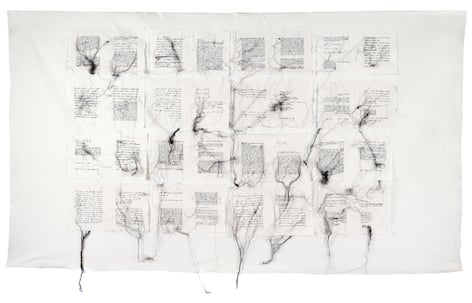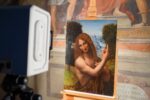Dadamaino / Maria Lai – Trovare l’ignoto

Mostra doppia personale.
Comunicato stampa
Galleria Six è lieta di annunciare la mostra DADAMAINO E MARIA LAI. TROVARE L'IGNOTO, con testo in catalogo di Elena Pontiggia, in collaborazione con Archivio Dadamaino e Archivio Maria Lai. Opening ore 17.30 con un'introduzione di Elena Pontiggia.
Dedichiamo questa mostra ad Annalisa Guidetti.
Si ringrazia Walter Baldi.
Come la stessa Elena Pontiggia scrive:
Alla fine dell'Ottocento Arthur Rimbaud si augurava che nascesse finalmente un' epoca in cui la donna potesse raggiungere la piena libertà (o, per citare le sue parole ben più crude, in cui “l'uomo, che finora si è comportato in modo ignobile nei suoi confronti, la lasciasse libera”). “Le poetesse saranno” continua Rimbaud, e aggiunge: “La donna troverà l'ignoto”.
E’ nata l’epoca che Rimbaud profetizzava? È lecito dubitarne, osservando certi dati della cronaca e della storia di oggi. Ma è lecito anche non dubitarne, osservando altri dati, tra cui l'opera di tante artiste contemporanee. Fra queste spiccano in modo del tutto speciale Dadamaino e Maria Lai che qui, grazie a una felice idea di Galleria Six, sono accostate per la prima volta in una personale. Certo, alcune collettive le avevano già viste vicine, eppure un focus su di loro come questo, piccolo ma emblematico, ci sembra che non sia mai stato proposto.
Le due artiste, si intende, sono diversissime e la mostra non vuole affatto proporre chissà quali raffronti o suggerire affinità inesistenti tra le loro opere. Del resto un artista è sempre diverso dagli altri, altrimenti non è un artista ma un epigono. Dadamaino e Maria Lai, in particolare, sono diverse per nascita (la prima nasce a Milano nel 1930; la seconda a Ulassai, in Sardegna, nel 1919), per formazione, per il clima artistico in cui sono vissute e, più ancora, per poetica (la prima, esponente nel 1960 del gruppo Azimut di Manzoni e Castellani, si avvicina poi all’arte optical e programmata; la seconda, vissuta a Roma dal 1956 alla fine del secolo, dopo esordi nell’ambito del realismo, e più tardi dell’informale, è stata un’interprete dell'arte concettuale e una anticipatrice dell’ arte relazionale).
Tuttavia entrambe, nel loro percorso espressivo, hanno trovato l'ignoto. Cioè, potremmo anche dire, hanno capito che siamo immersi nel mistero. E ce lo hanno mostrato, quel mistero, non per svelarlo (cosa velleitaria e impossibile), ma per rivelarci che il mistero c’è.
Per l'occasione alla data del 18 dicembre, si inaugurerà il nuovo format di Galleria Six con l'esposizione di un'opera di Maria Lai nel nuovo spazio di Venezia in Calle de la Vida San Marco, 2530.
Galleria Six is pleased to announce the exhibition DADAMAINO E MARIA LAI. TROVARE L'IGNOTO, with catalogue text by Elena Pontiggia, in collaboration with Dadamaino Archive and Maria Lai Archive. Opening 5.30 pm with an introduction by Elena Pontiggia.
We dedicate this exhibition to Annalisa Guidetti.
We are grateful to Walter Baldi.
As Elena Pontiggia herself writes:
At the end of the nineteenth century, Arthur Rimbaud hoped that an era would finally dawn in which women could achieve full freedom (or, to quote his far cruder words, in which "man, who has so far behaved ignobly towards her, would leave her free"). "The poetesses will be", Rimbaud continues, and adds: "The woman will find the unknown".
Was the era Rimbaud prophesied born? It is legitimate to doubt it, observing certain data from today's news and history. But it is also legitimate not to doubt it, observing other data, including the work of many
contemporary women artists. Among these, Dadamaino and Maria Lai stand out in a very special way, and here, thanks to a happy idea of Galleria Six, they are brought together for the first time in a personal exhibition. Certainly, they had already been seen together in some group exhibitions, but a focus on them like this one, small but emblematic, seems to us to have never been proposed.
The two artists are, of course, very different and the exhibition is in no way intended to make any kind of comparison or suggest non-existent affinities between their works. After all, an artist is always different from others, otherwise he is not an artist but an epigone. Dadamaino and Maria Lai, in particular, are different by birth (the former was born in Milan in 1930; the latter in Ulassai, Sardinia, in 1919), by training, by the artistic climate in which they lived and, even more so, by their poetics (the former, an exponent in 1960 of Manzoni and Castellani's Azimut group, then moved towards optical and programmed art; the second, who lived in Rome from 1956 to the end of the century, after her beginnings in the sphere of realism, and later in informal art, was an interpreter of conceptual art and an anticipator of relational art).
However, both of them, in their expressive journey, have found the unknown. In other words, we could also say that they understood that we are immersed in mystery. And they have shown us that mystery, not in order to unveil it (which is unrealistic an impossible), but to reveal that the mystery exists.
For the occasion on 18 December, the new format of Galleria Six in Venice will be open with the exhibition of a work by Maria Lai , Calle de la Vida San Marco, 2530.



